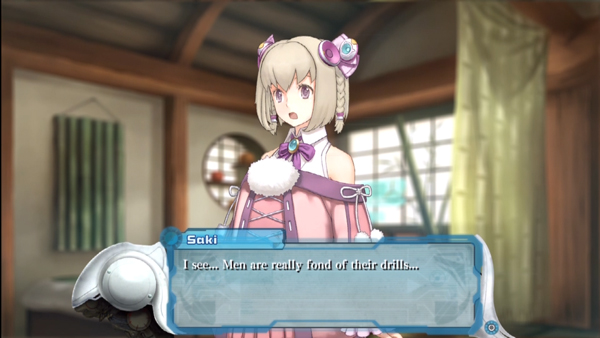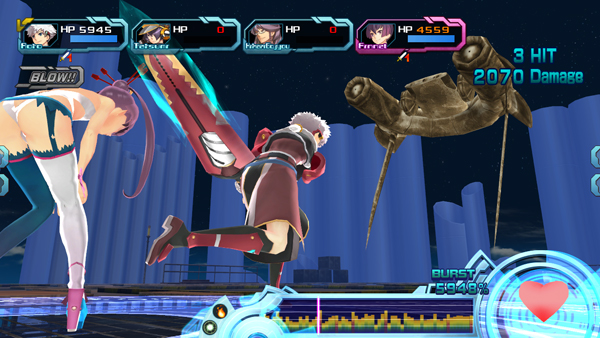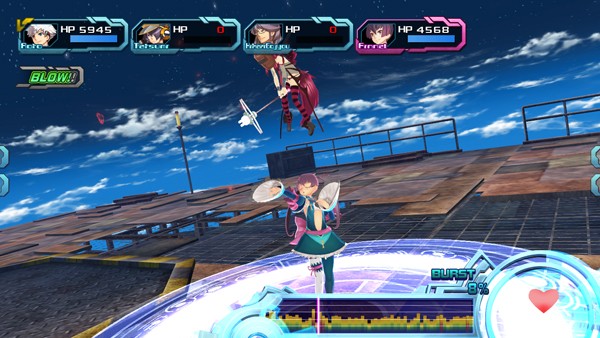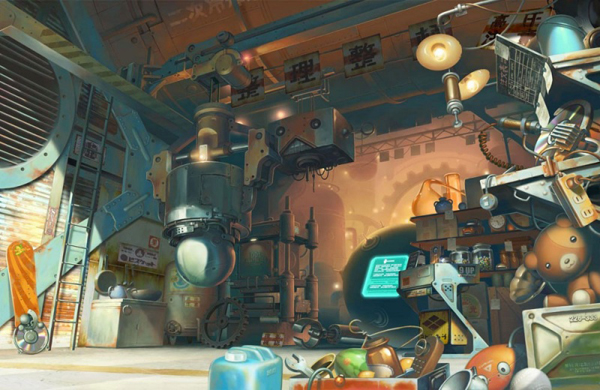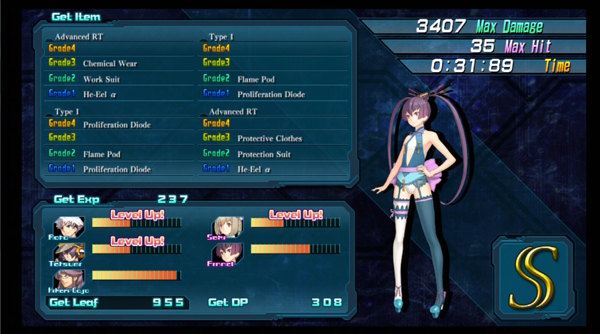This year-and-a-half old role-playing game finally gets a review.
To be fair, I did post this review on the Thumb Culture website when the game released (with a 10/10 score). But now we’ve a re-post, a revisiting. Why now? Chiefly because I didn’t think of doing so until now. We’re no newcomers to the game here; I nominated it for GOTY 2011, and Wayne referenced its tunes in his contribution to the Great Gaming Music of 2011 article. That makes two of us, and two is plenty. So without further ado I give you a review!
Imagine yourself in a universe where sound, in its vacillating harmonies and disharmonies, is ultimate. You’ve been deposited among cloud-scratching towers, fashioned with ornamental horns, valves and other musical décor. A gossamer humming permeates the place, so soft that its slightness tickles your mind. To your right, a chipper maiden sips at a glass of chunky barbeque soda, paying your sudden appearance little heed. Acoustics are responsible for all of this: from the meaty steak-pop to the aloof lass to the bronze embellished skyscrapers. The female is a reyvateil, the pied piper of clefs. Should the girl will it, she could croon a melody rife with emotion, pluck with bbq-coated lips at the chords of melancholy or elation. She could lull you to perfect health or summon a napalm spewing charnel beast.
This is the world of Ar Ciel. Life clings desperately to mechanical towers floating above the vaporous death that shrouds the uninhabitable land below.
In Ar tonelico Qoga, you play the snowy-haired, slapdash steeplejack, Aoto. He’s the head first sort of guy—kind but gullible and possessing a valiance bordering on insanity. Or stupidity. The latter, for certain. Stepping into his hip-flashing trappings, you’re living a quiet life as a construction worker in a backwater city. You sleep in late. Your days include climbing to pernicious heights and occasionally chatting with your V-boarding pal, Tatsumi. Uneventful. Humdrum. Pedestrian.
Until, behold, you’re unpredictably swallowed by turmoil. This never happens in role-playing games. The Clustanians, a despotic reyvateil suzerain that treats humans like cattle, disrupt your peaceful life when they invade your village. A confrontation erupts beyond your front door: Clustanians attempting to abduct a pair of humans. Ever the champion of justice, you interfere, thwarting the abduction with your uber-manly drill of drilltacular manliness. You fight with a drill. You drill people. According to the game’s assessment, drills have ranked as the prime desire of men for upwards of seven centuries. If you’re male, then you’ve ceased reading and left to purchase the game. If you’re female, let us proceed.
One of the pair you were defending has suffered mortal injuries. Thus, you naturally pledge your life to protect his cohort. Who doesn’t go around pledging to protect complete strangers? So you’re indentured to a lass who, until twenty seconds ago, was an armor-clad war goddess. Now, she’s completely transformed into a dainty, timid sweetheart with puff-balls dangling from her cotton candy dress. Changing forms: again, entirely normal. “Saki is grateful,” the girl mutters in head-tilting third-person while mourning the loss of her companion.
The Clustanians do not relent with one defeat, however, forcing you and your ball ‘n’ chain to the lam. Evading your pursuers and protecting the precious pink-packaged damsel, you soon stumble into a maelstrom of harrowing adventures.
This is how Gust begins the Ar tonelico story’s valedictory elegy. It’s a sweeping, capturing and downright evocative journey. Ar tonelico Qoga: Knell of Ar Ciel places you on the Tower of Harvestasha, the final of three, with Ar tonelico I and II covering the remaining towers. The optimal experience would include completing Qoga’s predecessors, though it is hardly necessary.
For players intimate with the lore and history of Ar tonelico, the final entry commands a truly breathtaking culmination of a narrative well woven. The tale is spun so passionately, with such glimmering gold that Rumpelstiltskin could hardly believe it.
Sob not, newcomers! Even on its own, Qoga stands gallantly, hands on hips and eyes to the heavens. Were you to press your cheek against its contours, you would surely blush at the sensation. And I’m not referencing the glaring lasciviousness! Tales within tales within tales are stitched into the sort of quilt you’d seek on the chilliest of frosty days—the manner of comfort whose prime quality is heartwarming. So heartwarming, in fact, that you will shamble away from its many faces hemorrhaging pure, boiling emotion.
Any of these tales would be an empty carapace without the characters they’re wrapped around. Gust happens to specialize in these affairs, and boy does their forte shine. Even peripheral characters are granted an invigorating tongue tap at the magical life-giving lollipop. While non-player characters like the butch Mute impress, it is your immediate party that exudes the dandelion dust of fascination. Saki, ever the supportive and agreeable creature, represents silliness incarnate. Then stumbles Finnel, a clumsy tsundere-type, whose abundance of bows hint at the gift within. These delightful heroines open their heart to you.
Gently, impatient one. They are fragile things, irreplaceable snowflakes in your palm. By means of diving into a reyvateil heroine, you enter her Cosmosphere, an indexed area representative of her whole. It is here that you interact with her subconscious: her deepest desires, most mortifying fears and long-buried secrets. Diving is a large and important element of Ar tonelico Qoga. It plays like a visual novel, sending you through events and decisions whose purpose is twofold.
Through a reyvateil’s Cosmosphere, you access her truest feelings. These encounters can unfold in a variety of ways, but they’re most often illustrated by a short story. In each level of a Cosmosphere, you stand against your heroine’s inner thoughts and any misgivings or suffering that may entail. By aiding your companion, your character grows closer to the maiden, hidden facets of her personality are illuminated and you will have helped to assuage some bundled turbulence.
All of this is spiced with an unabated lecherousness intrinsic to the Ar tonelico series. It is not a timid creature, and much of the game relies on stripping your partner to power her up. If you can withstand your pristine chastity being tarnished by sexual content, the scenes aren’t cloying. Often, they’ll serve as comic relief or to fortify a developing relationship. If you’re into furtive midnight trysts, then well, you should be pleased.
While serving as an unguent is fulfilling, that isn’t the only result Diving can yield. Squashing insecurities and helping your cohorts come to terms with their past also unlocks Hyuma. These are fairy-like entities which you can equip in combat to add supplementary effects to that character’s battle song. These can range from healing augmentation to resistance against ailments and can prove to be quite impactful in combat.
Which leads us to the drill-skewering, board-slapping, kit-spewing, beat-bursting battle system. Ar tonelico Qoga is a departure from its ancestors, adopting the action format where turn-based had previously flourished. Music, the omnipresent overseer, still plays a vital part in your approach to quenching your adversaries’ fire. Qoga introduces the Harmograph, a bar that displays the song your reyvateil is currently singing. As a vanguard unit—those putting their expendable lives on the line to protect the bellowing maiden—you time your attacks with the rises in the Harmograph to increase the beat. After accumulating enough of these, you can then Purge your reyvateil by furiously shaking your Sixaxis. Furiously.
Purging a heroine will result in a prurient animation wherein a layer of her clothing is eliminated. This grants the party the beneficial effects of Hyuma, changes the track and eventually enables skills whose puissance slumbers somewhere between demi-god and deity. The longer your mademoiselle chants, the higher your burst percentage rises, which increases the potency of her song’s magic and effects. Though not the pinnacle of real-time fighting, all this works well together to result in a multi-tier combat system.
Speaking of departures, Qoga is quite the rebellious little ankle-gnawer. Following a harshly worded lecture from its predecessors, it shuns the legacy of stunning second dimension for the third. Like Atelier Rorona and Atelier Totori, Gust handles the youngster with commendable artifice, taking to the third dimension like childhood friends. During exploration and the inescapable clashing of blades, characters are rendered in anime-style 3D. There is no loss, though. Do not pack up your bags. We’re not leaving. In fact, it’s nice here. It smells of ozone. These aren’t mind-blowing sculptures that will render your video card twain, but they excellently capture the design of each character.
This is no homogeneous temper tantrum, though. Ar tonelico Qoga is bound to the mercurial whim of adolescents. Boroughs, Cosmospheres and character portraits remain illustrations, lending their character to a game with a respectable paunch of personality. Villages, shops and Cosmosphere areas are depicted with such adamant creativity and intricacy that you’ll oft raise a hand to wipe the drool from your chin. During conversation, the participants are represented by portraits that wear expressions indicative of the discourse. Saki will equip an insuperably cute puffer-fish face when she’s exasperated. The awkward embarrassment that grips Finnel’s countenance is a perfect fit.
When a game is so mired in music, it holds some obligation to deliver in that department. Well, hello mister purged mailman! Who’s that large parcel for? At first, you may question Qoga’s musical truffles. The great disparity between refrains will confuse you. Ar tonelico Qoga is a patchwork of dulcet incantations: hopping happy to stomping mad to whisk-me-away, my glorious prince romantic. The flurry will leave you with stars in your eyes.
Then something happens, something magical yet not unfamiliar. It will all come together. You won’t recall when the sweet twitterfly fluttered into your ear canal. Nonetheless, it will nest there. Its young will nibble at your brain, fledgling notes whose incessant niggling over the finest piece of grey matter is a strangely bewitching diapason. You’ll think the parasites aren’t so bad as they slowly steal your sentience.
This harmonious expedition isn’t just happenstance. Someone had to apply the touch of translation, of squabbling over the last Funboon while their black tea sent wispy objections between their flaring nostrils. As with Ar tonelico I and II, NIS America stepped up to the arduous task. They were charged with taking the game, slapping on our foul, foreign language and making it seem like it belonged. Translating a title is a simple matter of knowing its native language. NISA localizes, and they used a lot of spit in their shine.
Playing with Japanese voices, you can tell when NISA took a phrase that was either abnormally brief or underwhelming and injected that extra oomph. Do this so many times and you have an oomph-filled role-playing game. That’s what you can call this localization effort: oomph-filled. Oomphy. NISA did their part in bringing this game to English speakers with the creative vim they’ve made themselves known for while respecting Qoga’s original content.
Negligible niggling commences:
Brrr: My game froze a few times. I cannot determine whether it was the system or software at fault.
One-eyed what?: Shaking your controller to purge requires a bit too much force.
Jailbait: Apparently, the heroines’ original ages were too young for western audiences, so they were increased. While this is understandable from a marketing standpoint, it does set some lore askew.
Ar tonelico Qoga strums a mellifluous marriage between visual novel and role-playing game. If you fancy yourself a follower of either genre, skipping the wedding would be truly lamentable. Qoga offers a superlative jaunt for players eager to have their heart snatched, wrenched and drowned in a torrent of gripping entertainment.
As both the Ar tonelico finale and a stand-alone title, Qoga yearns to be in the role-playing enthusiast’s library. Don’t let its yearning go unanswered. You will regret it.
I would like to point out that, despite the worthiness of Ar tonelico Qoga: Knell of Ar Ciel, the title is often obtrusively lewd. If you have an aversion to anything of the sort, it is not for you.


